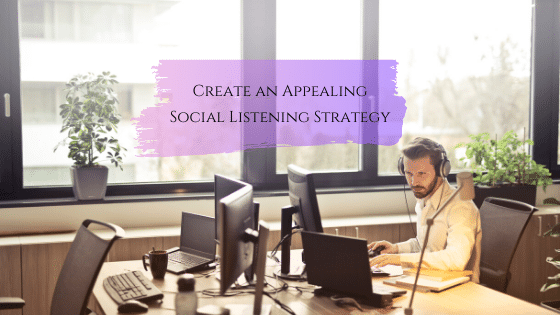Social media sites have matured influencing the way businesses are carried out online. And this information may not be new to you. Social listening has become a tool to drive online sales. Savvy brands today listen in to their customers and stay informed of the sentiment around their brand.
As brands strive to survive amidst rising and falling trends, they are required to constantly keep an eye out for their rivals. Brands adopt creative marketing techniques like influencer marketing to be in sync with current trends. In 2020, one of your marketing goals should be to build a social listening strategy.
How does Social Listening Work? What exactly is Social Listening Strategy?
Social listening is made possible by a software tool, an application that monitors online conversations. Say your brand is called “A2B3 technologies” and the name gets mentioned online, on a social media site, a review platform or elsewhere. The social listening tool tracks the comment and send you an alert. It also tells you who commented, their age, gender, geographical location and even the tone of the comment.
Now with billions of Internet users, there could be hundreds of people talking about your brand. The tool aggregates all of this data. It then analyses the overall percentage of comments, whether negative or positive and presents them to you. It will also analyze the other demographic details to offer you insights into your popularity or lack thereof, by geographic location.
Social listening tools also help you zero in on a potential pain point or strength. Say 68% of your users commented repeatedly that your product is great but they would like “A2B3 technologies” to provide free installation services for their product. As a result, your potential customers might hesitate to buy your product and start looking for alternatives who do provide installation.
With the right social listening tool, you can learn about reviews that are likely to snowball, in real-time. You can respond to the unhappy customers almost immediately, get them to change their minds about you and avert a PR crisis for your brand. You can also gain insight into how to provide better customer service and improve your customers’ experience.
A social listening strategy is nothing but you planning your goals and selecting a social listening tool to get optimum results.
Let’s get started with creating a Social Listening Strategy
You now know what social listening is all about, which is great. In addition to this, you need to understand the steps to getting the process started. What you want from your social listening tool is usually dictated by your business goals. So here we break down the steps to offer some simple pointers for your social listening strategy.
Fix your goals
The basis for building a robust social listening campaign lies in knowing what you need from the tool. As we mentioned before, a social listening tool can be your ultimate stop for all your marketing needs. It can offer you information and insights into all the following:
- Leads
- Business insights
- Real-time feedback
- Sentiment analysis
- Influencers and advocates
- Pointers for customer service and many more
You might just be looking for a way to know your customers better, and gain leads. Or you might be looking for the current marketing trends and influencers. Once you define your goals, you can fine-tune the platform to deliver the results.
Engage in Market Research
With social listening tools, you have access to digital data. Use this for thorough market research. The information you receive from social listening comes directly from the users and usually isn’t biased. You can use it to know about your target audience. When you enter your brand’s name and the names of your competitors, the tools pull up the handles of people who mentioned you. Analyze their kind, the demographics, location, preferences et cetera. You will know who your target audience is. Similarly, use the data to monitor current trends or industry news. Trends are heavily discussed online, so it’s impossible to miss it if you wish to monitor trends related to your brand.
Customer Service and Reputation Management
The most common use of the real-time alerts you get via social listening tools is customer service. Marketers study the data to know the queries and perception their audience has. When you analyze the feedback from your customers, you understand the overall sentiment towards your brand. This helps you gauge ways to improve customer service and to monitor your brand’s online reputation. And when you engage with your customers in real-time, the focus and commitment demonstrated will only help your brand. According to research reports, 71% of customers who receive a quick response from a brand are more likely to recommend them.
Influencer Outreach
The purchasing behavior of youngsters today is driven by online and word-of-mouth reviews. If an influencer talks about a favorite product on his or her blog, chances are that his/her followers will try out the same product. It’s human nature to trust fellow human beings. In this scenario, social listening tools help you search for your perfect influencer. If you are into a tech business, find an influencer whose forte lies in tech reviews. If you wish to work with micro-influencers, social listening tools can help you find them too. Just set the filters to highlight the influencer scores.
An effective social listening strategy will require multiple iterations. But once you invest the time and energy, the results will prove worthy of the efforts you put in.




